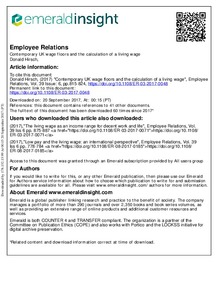Contemporary UK wage floors and the calculation of a living wage

Employee Relations. The International Journal
2017
39
6
815-824
guaranteed income ; living conditions ; minimum wage ; living wage
Wages and wage payment systems
https://doi.org/10.1108/ER-03-2017-0048
English
Bibliogr.
"Purpose
The purpose of this paper is to describe how the voluntary living wage (LW) in the UK is set. It examines how this calculation relates to contemporary approaches to setting wage floors, both in relation to their goal of supporting adequate living standards and in relation to the place of wage floors in the labour mark.
Design/methodology/approach
The paper examines how compulsory and voluntary wage floors are being determined, in the UK and in particular the role of public consensus in contributing to the calculation and adoption of a LW. It then reflects on the future sustainability of a system of wage floors in which the concept of the LW plays a significant role.
Findings
The central finding is that widespread support for wages delivering socially acceptable minimum living standards has transformed the context in which low pay is being addressed in the UK. The LW idea has stimulated more decisive efforts to do so; however, if a compulsory version of a LW were to reach a level shown to be harming jobs, this could seriously undermine such efforts. Moreover, the extent to which adequate wages are compatible with high employment levels can also be influenced by state support for households, especially tax credits and Universal Credit.
Originality/value
The paper clarifies how the setting of the UK LW contributes to objectives related both to living standards and to labour markets, and critically addresses some key issues raised."
Digital
The ETUI is co-funded by the European Union. Views and opinions expressed are however those of the author(s) only and do not necessarily reflect those of the European Union or the ETUI.